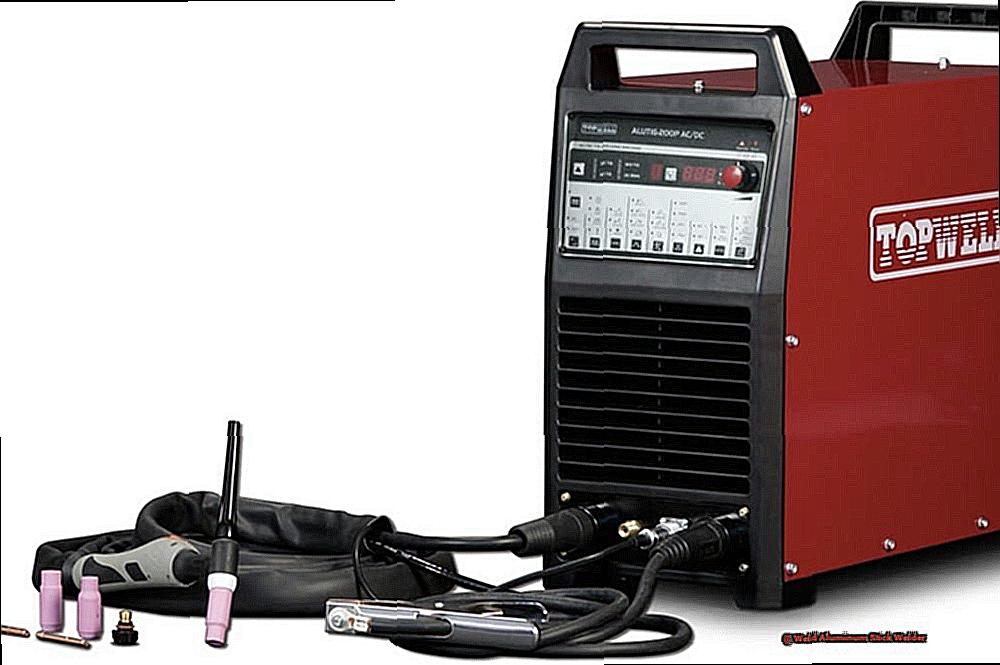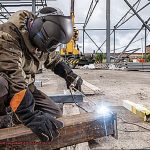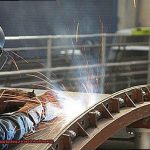Welcome, fellow welding enthusiasts, to our blog dedicated to the art of welding aluminum with a stick welder.
If you’re new to the world of welding, you may be wondering why we’ve chosen to focus on this specific combination. Well, let us tell you – welding aluminum is no easy feat and requires a unique approach compared to other metals.
And while stick welding is often associated with heavy-duty projects, it can also be a valuable technique for working with aluminum. So whether you’re an experienced welder looking to expand your skills or a curious beginner eager to learn more about this versatile process, this blog is for you.
So without further ado, let’s dive into the world of welding aluminum with a stick welder.
What is Stick Welding?
Contents
Stick welding, also known as shielded metal arc welding (SMAW), is a versatile and cost-effective method of joining metals. It utilizes heat and pressure to fuse metal pieces together, making it a popular choice in various industries such as construction, manufacturing, and automotive.
But what makes stick welding stand out from other types of welding? And is it possible to weld aluminum using this method? Let’s delve into the intricacies of stick welding to answer these questions.
The Key Differences between Stick Welding and Other Types of Welding
Stick welding and MIG (metal inert gas) welding are two commonly used methods for metal joining. The significant difference between the two lies in the type of electrode used. While stick welding allows for the use of various electrodes, MIG welding only utilizes a wire electrode.
Moreover, stick welding is generally considered to produce higher-quality welds compared to MIG welding. This is because stick welding creates a more stable arc, providing better control and precision during the welding process.
Another crucial distinction is that stick welding can be done both indoors and outdoors, while MIG welding is limited to indoor use due to its reliance on external gas shielding.
Challenges and Solutions for Stick Welding Aluminum
Although stick welding is primarily used for steel, it is possible to weld aluminum using this method. However, aluminum has unique properties that make it a challenging material to weld with a stick welder.
One of the main challenges when stick welding aluminum is its lower melting point and higher thermal conductivity compared to steel. This means that more heat is required to melt the metal and prevent it from cooling too quickly.
Additionally, aluminum forms an oxide layer when exposed to oxygen, making it difficult to create a strong bond during welding. This is where specialized electrodes come into play.
To successfully weld aluminum with a stick welder, you need to use an aluminum electrode or a “low hydrogen” electrode.
Types of Electrodes for Aluminum
Are you new to the world of welding or embarking on a project involving aluminum for the first time? If so, you may have encountered various types of welding electrodes and are now wondering which one to choose. Look no further. In this comprehensive guide, we will delve into the different types of welding electrodes specifically designed for aluminum, recommend the best brands to use, and highlight other essential supplies needed for a successful welding experience.
From Stick to Success: Stick Welding Electrodes
Stick welding is a popular technique that involves using a consumable electrode coated in flux to create an electric arc between the electrode and the base metal. This method is suitable for both AC and DC currents and can be used to weld various metals, including aluminum. However, when it comes to welding aluminum with a stick welder, special electrodes known as “low hydrogen” electrodes are recommended. These electrodes have a high silicon and magnesium content, making them ideal for penetrating the oxide layer on aluminum’s surface and creating a strong bond.
Recommended Brands: Lincoln Electric and Hobart.
TIG (Tungsten Inert Gas) welding is a versatile and precise technique commonly used for thin materials like aluminum. It utilizes a non-consumable tungsten electrode to create an arc between the electrode and the base material. The weld is then created by manually adding a filler rod. While TIG welding may be challenging, it produces high-quality, clean results.
Spot Welding: Fusing with Copper Electrodes
Spot welding is a form of resistance welding typically used in automotive and manufacturing industries. It employs copper electrodes to apply pressure and heat to two metal pieces, fusing them together at specific points. To withstand the high heat generated during this process, spot welding electrodes must be made of high-quality copper.
Amperage Settings for Aluminum
One crucial aspect of welding aluminum is selecting the correct amperage setting. In this section, we will delve into research notes and previous content to provide you with a comprehensive understanding of “Amperage Settings for Aluminum.”
Welding aluminum using the stick method is not as simple as welding other metals. Its low melting point and susceptibility to heat distortion make it a challenging material to work with. Therefore, choosing the appropriate amperage setting is crucial in achieving a successful weld.
But what exactly is amperage, and how does it impact the quality of your weld? Amperage refers to the amount of electrical current flowing through the welding machine. The higher the amperage, the more heat is generated, and conversely, a lower amperage setting produces less heat. This heat is essential in melting the aluminum and fusing it together.
Experts in the industry recommend a range of 70-90 amps for stick welding aluminum. However, this range may vary depending on several factors, such as the thickness of the aluminum being welded. Thinner aluminum sheets or plates may require a lower amperage setting, while thicker pieces may need higher amperage settings.
It is vital to note that these suggested settings are just guidelines and may differ based on other factors, such as electrode size and type of stick welding machine used. Therefore, it is crucial to conduct test welds on scrap pieces of aluminum before starting your actual project. This will help determine the ideal amperage setting for your specific welding needs.
Another critical aspect to consider when determining the amperage setting for stick welding aluminum is the use of alternating current (AC) or direct current (DC). AC is commonly used for welding aluminum because it allows for deeper penetration and better control over the heat input.
Challenges of Stick Welding Aluminum
Stick welding aluminum is an art that demands a high level of skill and expertise. While it boasts several benefits, such as portability and versatility, it also presents unique challenges. As someone who has spent years honing my stick welding craft, I am well acquainted with the struggles of working with aluminum. In this section, I will delve into the common obstacles that stick welders encounter when welding aluminum and offer practical solutions to help you produce impeccable welds.
Arc Quality: A Complex Conundrum
One of the primary challenges of stick welding aluminum is achieving a smooth and stable arc. This can be attributed to its low melting point and high thermal conductivity, making it a perplexing task for even the most seasoned welders. To improve arc quality, precision is key. Adjusting amperage settings and maintaining the correct rod angle are crucial in creating a focused and stable arc. Too steep or too shallow of a rod angle can greatly impact the quality of your weld.
Electrode Sticking: A Sticky Situation
Another common issue faced by stick welders when working with aluminum is sticking electrodes. This frustrating occurrence happens when the electrode fuses to the workpiece, making it arduous to remove. To avoid this, it is crucial to master your striking technique and lower your amperage settings. A swift and fluid strike will prevent electrodes from sticking and ensure a smooth welding process.
Porosity: The Pores of Imperfection
Porosity is a common enemy for all types of welding, but it is particularly prevalent in stick welding aluminum. It occurs when gas pockets form within the weld, resulting in weak and brittle joints. When working with aluminum, it is essential to be vigilant of any drafts in your work area – even a gentle breeze can introduce impurities into the weld, leading to porosity. Additionally, thoroughly cleaning your material before welding can also help prevent this issue.
Pre-Weld Preparation for Aluminum
With its high thermal conductivity and susceptibility to oxidation, aluminum requires specific preparation techniques for a strong and secure weld. In this blog article, I will share my extensive knowledge and experience to guide you through the pre-weld process for aluminum using a stick welder.
Select the Appropriate Electrode
When it comes to welding aluminum, using the correct electrode is paramount. Aluminum welding electrodes are crafted from a different alloy than those used for other metals, with a flux coating that prevents oxidation during the welding process. Using the wrong type of electrode can result in subpar welds and potential safety hazards. Always ensure that you choose an electrode specifically designed for aluminum welding.
Thoroughly Clean the Aluminum Surface
Aluminum is highly susceptible to oxidation, which forms a layer of oxide on its surface. This layer can make it challenging for the electrode to penetrate and create a strong bond. To achieve a successful weld, it is crucial to thoroughly clean the aluminum surface before starting the welding process. You can use a stainless steel brush or specialized chemical cleaners designed for aluminum to eliminate any dirt, oil, or other impurities.
Preheat the Metal
Due to its high thermal conductivity, aluminum dissipates heat rapidly. This makes preheating essential before welding, especially if you are working with thick or large pieces of metal. Preheating helps reduce the risk of cracking and ensures proper fusion between the base metal and the weld. The ideal preheating temperature will vary depending on the thickness and size of the aluminum, so be sure to refer to a preheat chart for guidance.
Utilize AC Current
Unlike other metals that can be welded using direct current (DC), aluminum requires alternating current (AC).
Conclusion
In conclusion, we hope this blog has provided you with a comprehensive understanding of stick welding aluminum. From grasping the fundamentals to navigating the complexities of this process, we have covered it all. We also delved into the various types of electrodes and recommended brands, giving you the necessary information to make informed choices.
Choosing the correct amperage settings is crucial when stick welding aluminum, and we highlighted the challenges that come with it. But fear not, as we also provided practical solutions to help you overcome these obstacles and achieve successful welds.
Pre-weld preparation cannot be emphasized enough when working with aluminum. Thoroughly cleaning the surface, carefully selecting the right electrode, and preheating the metal are vital steps in achieving top-notch results.
Stick welding may be considered a challenging technique for working with aluminum, but with practice and proper knowledge, it can produce high-quality welds. Whether you’re an experienced welder looking to expand your skills or a curious beginner eager to learn more about this versatile process, we hope this blog has been informative and helpful in your journey towards mastering the art of welding aluminum with a stick welder.





